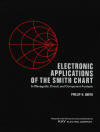 One of the few aspects of electronics that
has not changed since the early days of the craft is impedance matching and, in
particular, use of the Smith Chart. Many an engineer, technician, and hobbyist has
been intimidated by the chart's appearance; however, after using the Smith Chart
a few times for impedance and/or admittance matching, quickly develops the knack
of applying it. If you have an affinity for mathematics and are comfortable with
complex numbers, all the arcs and circles makes perfect sense once the simple equations
governing its construction are presented. As with so many other things, you wonder
how anyone ever thought to do such a thing, and at the same time wonder why it took
so long for someone to think of it.
One of the few aspects of electronics that
has not changed since the early days of the craft is impedance matching and, in
particular, use of the Smith Chart. Many an engineer, technician, and hobbyist has
been intimidated by the chart's appearance; however, after using the Smith Chart
a few times for impedance and/or admittance matching, quickly develops the knack
of applying it. If you have an affinity for mathematics and are comfortable with
complex numbers, all the arcs and circles makes perfect sense once the simple equations
governing its construction are presented. As with so many other things, you wonder
how anyone ever thought to do such a thing, and at the same time wonder why it took
so long for someone to think of it.
RF Cafe visitor Gary Steinhour (KF6U), who recently donated a part of his cardboard
slide rule calculator collection for display here, also very generously provided
this mint condition copy of
Phillip H. Smith's classic Electronic Applications
of the Smith Chart in Waveguide, Circuit, and Component Analysis book (1969
edition). It even has the KAY Electric Company postcard in it and the transparencies
for use on overhead projectors. Used copies are sometimes available on
Amazon, and on
eBay as well. Prices range from about $100 up to $1,000. depending on condition
and whether the original transparent overlay charts are included.
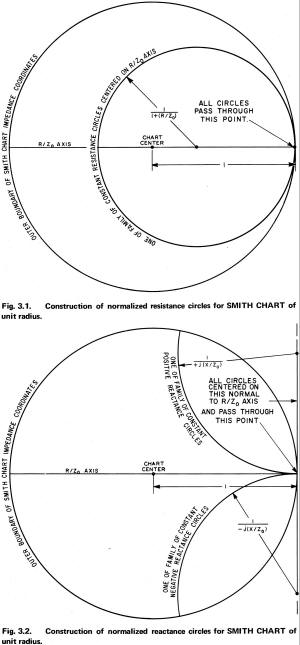
Construction of Normalized Circles on the Smith Chart
Having been written by the Smith Chart's inventor, first-person insight into
its history is gained. For instance, prior to conceiving of the circular version
of the Smith Chart in 1938 (first published publically in 1939), Mr. Smith
devised an impedance matching chart using rectangular coordinates. In 1949 the labeling
of the chart was changed so it would display directly either normalized impedance
or normalized admittance, and in 1966 radial and peripheral scales were added to
show the fixed relationship of complex transmission coordinates. That is the version
universally used today.
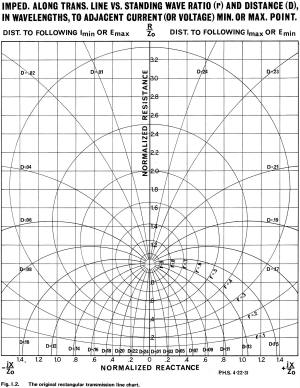
Original Rectangular Transmission Line Chart
If you have the interest and the time to really delve into the deep intricacies
of the Smith Chart, then this is the book for you. The book is chock full of tutorials
and application examples. A few if the more interesting illustrations are presented
here to whet your appetite.

Vector Representation of Phase Relations for Voltages on Impedance
Coordinates
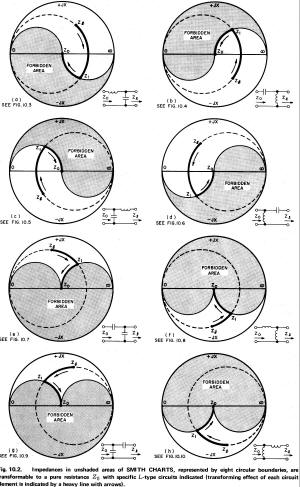
Forbidden Areas of the Smith Chart

 A colorful version
of the forbidden areas theme is printed on many types of RF Cafe T-shirts, hats,
and more, using the title "RF Engineers...We Are the World's Match Makers".
A colorful version
of the forbidden areas theme is printed on many types of RF Cafe T-shirts, hats,
and more, using the title "RF Engineers...We Are the World's Match Makers".
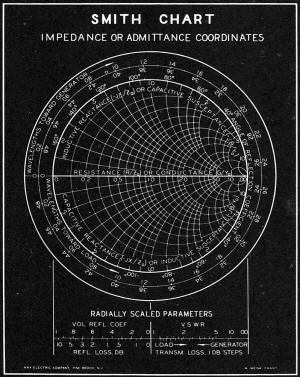
Blackboard Smith Chart for Classroom Use
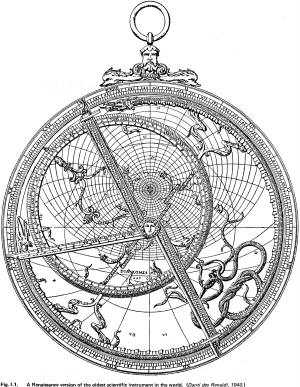
Renaissance Version of Oldest Scientific Instrument in the World
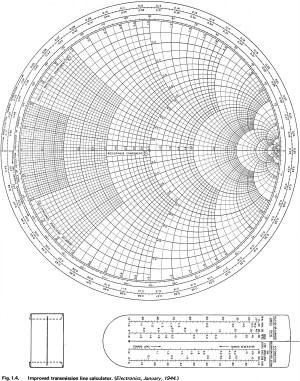
Improved Transmission Line Calculator
 Although I began by asserting that the Smith
Chart has not changed in most readers' careers, in fact there has recently been
a new twist added - a 3-dimensional version created by Andrei Muller and cohorts.
"The 3D Smith Chart demo
version has 3 planes: normalized impedance plane, reflection plane and 3D Smith
chart. One may draw the impedance and get the image of it on the reflection coefficient's
plane or on the 3D Smith chart. On the 3D Smith chart one can rotate it and play
with the constant r,x, and abs(z) circles. The 3D Smith chart includes both extended
reflection and impedance planes." It will take a bit of experimentation to figure
out exactly what is going on in 3D after years of using the standard 2D version
we are all familiar with. Andrei says that for now, there is no plan to extend the
functionality beyond plotting of S-parameters, but he and his co-developers are
open to working with someone that is interested in integrating the concept into
a commercial application. It is copyrighted so permission is required. See also
"New RF Applications for the 3-D Smith Chart."
Although I began by asserting that the Smith
Chart has not changed in most readers' careers, in fact there has recently been
a new twist added - a 3-dimensional version created by Andrei Muller and cohorts.
"The 3D Smith Chart demo
version has 3 planes: normalized impedance plane, reflection plane and 3D Smith
chart. One may draw the impedance and get the image of it on the reflection coefficient's
plane or on the 3D Smith chart. On the 3D Smith chart one can rotate it and play
with the constant r,x, and abs(z) circles. The 3D Smith chart includes both extended
reflection and impedance planes." It will take a bit of experimentation to figure
out exactly what is going on in 3D after years of using the standard 2D version
we are all familiar with. Andrei says that for now, there is no plan to extend the
functionality beyond plotting of S-parameters, but he and his co-developers are
open to working with someone that is interested in integrating the concept into
a commercial application. It is copyrighted so permission is required. See also
"New RF Applications for the 3-D Smith Chart."
I have a huge list of resources on the Smith
Chart here.
Posted May 26, 2015














 A colorful version
of the forbidden areas theme is printed on many types of RF Cafe T-shirts, hats,
and more, using the title "
A colorful version
of the forbidden areas theme is printed on many types of RF Cafe T-shirts, hats,
and more, using the title "



